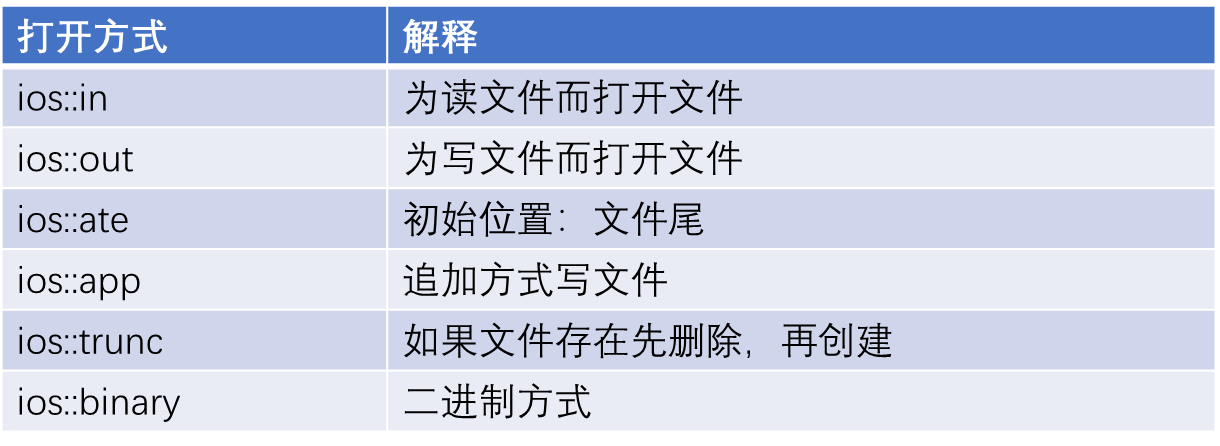【c++】文件操作(文本文件、二进制文件)

文件操作
程序运行时产生的数据都属于临时数据,程序一旦运行结束都会被释放;
通过文件可以将数据持久化;
c++中对文件操作需要包含头文件
文件类型分为两种:
1、文本文件——文件以文本的ASCII码形式存储在计算机中;
2、二进制文件——文件以文本的二进制形式存储在计算机中,用户一般不能直接读懂它们。
操作文件的三大类:
1、ofstream:写操作;
2、ifstream:读操作;
3、fstream:读写操作。
文本文件
写文件
写文件步骤:
1、包含头文件
#include
2、创建流对象
ofstream ofs;
3、打开文件
ofs.open(“文件路径”,打开方式);
4、写数据
ofs<<“写入的数据”;
5、关闭文件
ofs.close();
文件打开方式:

注意:
文件打开方式可以配合使用,利用|操作符
例如:用二进制方式写文件ios::binary | iostream::out
#include<iostream>
using namespace std;
//1、包含头文件fstream
#include<fstream>void test()
{//2、创建流对象ofstream ofs;//3、指定打开方式ofs.open("test.txt", ios::out);//4、写内容ofs << "姓名:张三" << endl;ofs << "性别:男" << endl;ofs << "年龄:18" << endl;//5、关闭文件ofs.close();
}int main()
{test();system("pause");return 0;
}
总结:
1、文件操作必须包含头文件fstream;
2、读文件可以利用ofstream,或者fstream类;
3、打开文件时候需要指定操作文件的路径,以及打开方式;
4、利用<<可以向文件中写数据;
5、操作完毕,要关闭文件。
读文件
读文件步骤:
1、包含头文件
#include
2、创建流对象
ifstream ifs;
3、打开文件并判断文件是否打开成功
ifs.open(“文件路径”,打开方式);
4、读数据
四种方式读取
5、关闭文件
ifs.close();
#include<iostream>
using namespace std;
#include<string>
//1、包含头文件fstream
#include<fstream>void test()
{//2、创建流对象ifstream ifs;//3、打开文件并且判断是否打开成功ifs.open("test.txt", ios::in);if (!ifs.is_open()){cout << "文件打开失败" << endl;return;}//4、读数据(四种方式)//第一种char buf[1024] = { 0 };while (ifs >> buf){cout << buf << endl;}//第二种/*char buf[1024] = { 0 };while (ifs.getline(buf, sizeof(buf))){cout << buf << endl;}*///第三种/*string buf;while (getline(ifs, buf)){cout<<buf<<endl;}*///第四种//char c;//while ((c = ifs.get()) != EOF)//EOF:end of file//{// cout << c;//}//5、关闭文件ifs.close();
}int main()
{test();system("pause");return 0;
}
总结:
1、读文件可以利用ifstream,或者fstream类;
2、利用is_open函数可以判断文件是否打开成功;
3、close关闭文件。
二进制文件
以二进制的方式对文件进行读写操作。
打开方式要指定为 ios::binary
写文件
二进制方式写文件主要利用流对象调用成员函数write
函数原型:ostream& write(const char* buffer,int len)
参数解释:字符指针buffer指向内存中一段存储空间。len是读写的字节数。
#include<iostream>
using namespace std;
//1、包含头文件
#include<fstream>class person
{
public:char m_name[64];//姓名int m_age;//年龄
};void test()
{//2、创建流文件ofstream ofs;//3、打开文件ofs.open("person.txt", ios::out | ios::binary);//也可以23步合并成//ofstream ofs("person.txt", ios::out | ios::binary);//4、写文件person p = { "张三",18 };ofs.write((const char*)&p, sizeof(person));//5、关闭文件ofs.close();
}int main()
{test();system("pause");return 0;
}
总结:
文件输出流对象可以通过write函数,以二进制方式写数据。
读文件
二进制方式读文件主要利用流对象调用成员函数read
函数原型:istream& read(char* buffer,int len);
参数解释:字符指针buffer指向内存中一段存储空间。len是读写的字节数。
#include<iostream>
using namespace std;
//1、包含头文件
#include<fstream>class person
{
public:char m_name[64];//姓名int m_age;//年龄
};void test()
{//2、创建流文件ifstream ifs;//3、打开文件,判断文件是否打开成功ifs.open("person.txt", ios::in | ios::binary);if (!ifs.is_open()){cout << "文件打开失败" << endl;return;}//4、读文件person p;ifs.read((char*)&p, sizeof(person));cout << "姓名:" << p.m_name << "\\t" << "年龄:" << p.m_age << endl;//5、关闭文件ifs.close();
}int main()
{test();system("pause");return 0;
}
总结:
文件输入流对象可以通过read函数,以二进制方式读数据。
